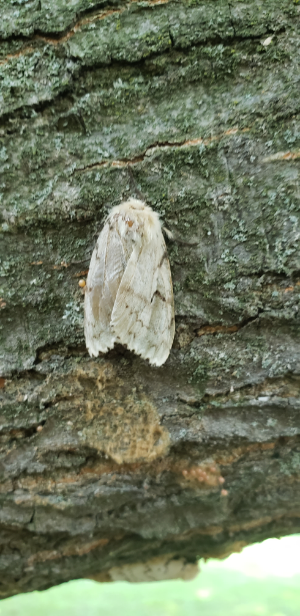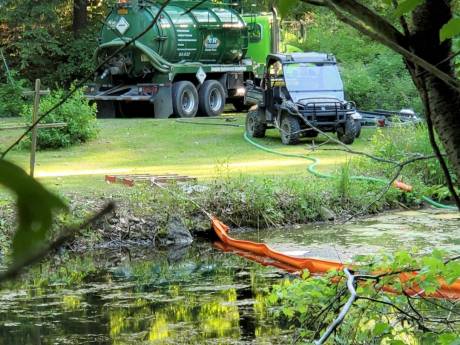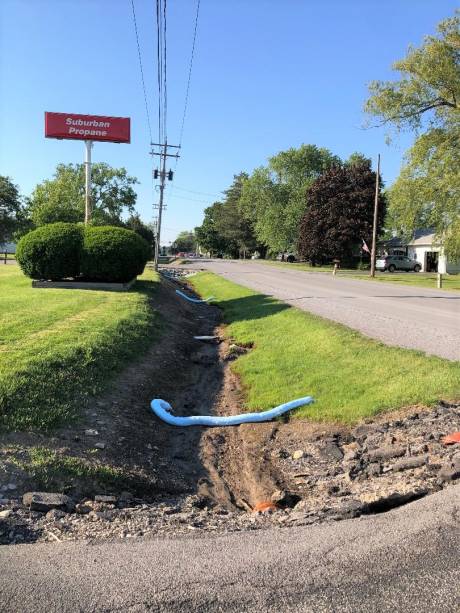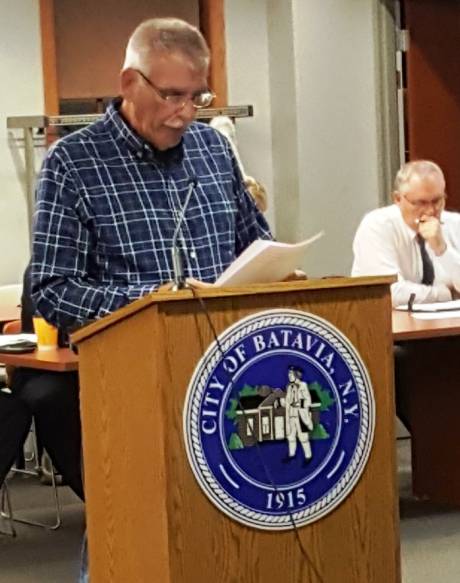O-At-Ka offers alternatives, claims city is protected as it seeks to end hauling of wastewater from its facility

Update: 6:30 p.m. -- See bottom of the story
----------------------
The chief executive officer at O-At-Ka Milk Products today said engineers at the Upstate Niagara cooperative-owned milk processing plant are prepared to present alternatives that would satisfy the City of Batavia and bring an end to a situation that is forcing the company to spend $25,000 to $30,000 per day hauling wastewater away from the facility.
The problem, however, according to Bill Schreiber, is that city management will not sit down with officials from O-At-Ka and the New York State Department of Environmental Conservation to iron out what he calls “a three-party solution that would be a win-win for everyone involved.”
Schreiber and John Gould, owner of Har-Go Farms in Pavilion and chairman of the board for Upstate Niagara, a consortium of 300 dairy farmers, spoke to The Batavian this morning.
They expressed their dismay over not being able to deposit all of its wastewater into the city’s Waste Water Treatment Plant and “a lack of urgency” from the city.
Gould brought this issue to public light at Tuesday night’s City Council meeting when he informed lawmakers of the staggering costs to haul the wastewater away from O-At-Ka.
Several minutes later, he learned from City Attorney George Van Nest that the municipality had no choice but to enforce a cease-and-desist letter it sent to O-At-Ka after discovering that discharge levels from the Cedar Street plant were above permitted limits.
Van Nest said the DEC sent a notice of violation to the city, threatening enforcement action and large fines because of the oxygen levels in the ponds.
Gould: 'There's Something Wrong Here'
Gould’s anger with the city’s stance came through in his comments earlier today.
“Back to the Council meeting, Mr. Van Nest, puts the fear of God into them with the DEC. So, everybody’s fearful of each other and we’re getting nothing done,” he said. “There was more discussion about who was paying for Christmas in the City then there was about the largest employer in the city and the economic impact upon it. There’s something wrong here.”
Contacted today, City Council President Eugene Jankowski Jr. said Council is leaving the matter in the hands of Van Nest, City Manager Rachael Tabelski and engineers working with the city.
“We’re following the advice of our attorney, which is basically telling Mr. Gould and the staff there that they are supposed to talk to the city manager and the city attorney. Those are the people that Council has delegated to address the issue.
“Mr. Gould is bypassing some things and that’s not really for me to say what he is supposed to do or not supposed to do, but we’re not going to comment on it. We’ll let the professionals handle it – the city manager, the engineers, the city staff take care of it.”
Schreiber: Pre-Treatment Plant Upgrade Underway
Schreiber, in his ninth year at O-At-Ka, said the company is about six to eight weeks away from completing a $6 million upgrade to its on-site pre-treatment facility – action that he said will bring an end to this impasse as the amount of Biochemical Oxygen Demand and Total Suspended Solids will return to acceptable levels.
Until that new pre-treatment facility is operational, O-At-Ka is taking a substantial financial hit.
When it was mentioned that the expense could be as much as $1 million over the next 40 days, Schreiber responded: “That puts our business at risk, it puts our customers at risk, it puts our employees at risk and it puts our farmer owners at risk. Absolutely.”
The CEO said he is aware that the city has to comply with its State Pollutant Discharge Elimination System permit, but is seeking for “a bridge” to get us to the start-up of the new treatment facility.
“And what we got in exchange was a cease-and-desist (letter from the city). We don’t understand the lack of cooperation coming out of the city,” he said. “And it’s our understanding that the DEC would be willing to work towards a three-part solution. We’ve sent several letters to the city and we’ve not received a response.”
Schreiber said there are four or five different alternatives that would serve to increase the dissolved oxygen levels in the city’s lagoons, which have yet to recover adequately following replacement of the air header system at the Waste Water Treatment Plant in late August.
“Some of them are routine maintenance; getting into the diffusers and lagoons and cleaning them. That would have an immediate impact,” Schreiber advised.
“There’s a device called a venturi, which essentially serves to incorporate oxygen into the lagoons. There are companies that work with hydrogen peroxide, which when added to the lagoons, breaks down into oxygen and water – and essentially elevates the oxygen levels in the lagoons.”
Furthermore, Schreiber said he “fundamentally disagrees that we’re putting the city and the city’s taxpayers at risk.”
Permit: O-At-Ka Would Be Responsible for Fines
He said the city is protected under Section III.4 of the Industrial Sewer Use Permit, as follows:
“If the User [i.e., O-At-Ka] discharges above its Permit thresholds to such a degree that it causes the Publicly Operated Treatment Works (POTW) to violate its SPDES Permit, the User shall be held responsible for the payment of any fines or penalties levied against the POTW. This is in addition to any extra costs associated with handling such discharges as provided for in the Sewer Use Ordinance.”
“O-At-Ka has told City officials both in writing and verbally that it accepts full responsibility for any fines and penalties issued by the DEC or any other regulatory body that are attributable to our discharges,” he added. “We welcome the inclusion of DEC in these discussions regarding regulatory liability.”
Schreiber said O-At-Ka is seeking “a comprehensive, long-term solution to this.”
“We’re not looking for a band-aid. We recognize that the city has to meet its use permit, and we want to be part of the solution. But there seems to be, in our view, a lack of urgency on the city’s part while we’re burning through cash. We would rather channel those dollars to a constructive solution than use them to haul wastewater away.”
He said there are implementable steps that can be taken at the Waste Water Treatment Plant that will allow for the easing of restrictions on O-At-Ka wastewater discharges without impeding the recovery of the ponds.
“O-At-Ka is not seeking permission to discharge indiscriminately to the city nor are we ignoring the impact high strength wastewater can have on the ponds. However, we are very confident that there are engineering solutions that can wholly offset the impact and further accelerate the health and recovery of the ponds.”
City Manager: 'We Can't Allow Willful Violations'
The Batavian reached out by email to Tabelski and to the DEC’s press office for comment.
Tabelski, speaking to WBTA Radio earlier this week, said O-At-Ka is “an industry here that we value for their employment and for the use of the milk supply that comes from the farms. That’s not lost on me. But we cannot allow willful violations of permits at the city Waste Water Treatment Plant.”
She also said that O-At-Ka officials acknowledged what they need to get to “a place that allows their discharge to be at a permitted level.”
“Right now, they can be at their permitted level, but they have to truck many, many truckloads of waste away. That’s showing that their capacity isn’t in line with their production,” she said.
Schreiber is calling for a “technical conversation that going to lead us to a resolution of this problem.”
Gould agreed, stating, “Collaboration to us is getting the stakeholders in the same room and sit down and solve the problem."
Schreiber said the O-At-Ka board of directors have approved $35 million in capital spending for 2021 and 2022, but “we’ll have to look really hard at where the next capital investment goes.”
He said completion of the pre-treatment facility will result in a permanent fix.
“As I said, we’re just looking for a bridge, and we can’t seem to get cooperation from the city,” he said. “The city seems to be blaming DEC; everybody but themselves, quite frankly.”
Update:
Comment from City Manager Rachael Tabelski: "In response to your inquiry, there continues to be an ongoing and open dialogue between city officials and O-AT-KA regarding discharge issues at the Waste Water Treatment Plant. As we also have communicated, public health and safety as it pertains to these discharge issues is our number one priority so that the WWTP is operating within all its regulatory obligations."
Statement from NYS DEC: "The New York State Department of Environmental Conservation (DEC) remains committed to working with all involved parties to develop and implement necessary solutions to address these issues. DEC will continue to meet with the city and O-At-Ka Milk Products regarding technical and infrastructure needs, and will convene additional meetings with these parties as these efforts progress."
Photo at top: O-At-Ka CEO Bill Schreiber and Upstate Niagara Chairman of the Board John Gould in front of the new equalization tank that is part of the company's ongoing upgrade of its pre-treatment facility. Photo by Mike Pettinella.
Previously: City sends 'cease and desist' letter to O-At-Ka Milk as issues at waste water treatment plant continue




